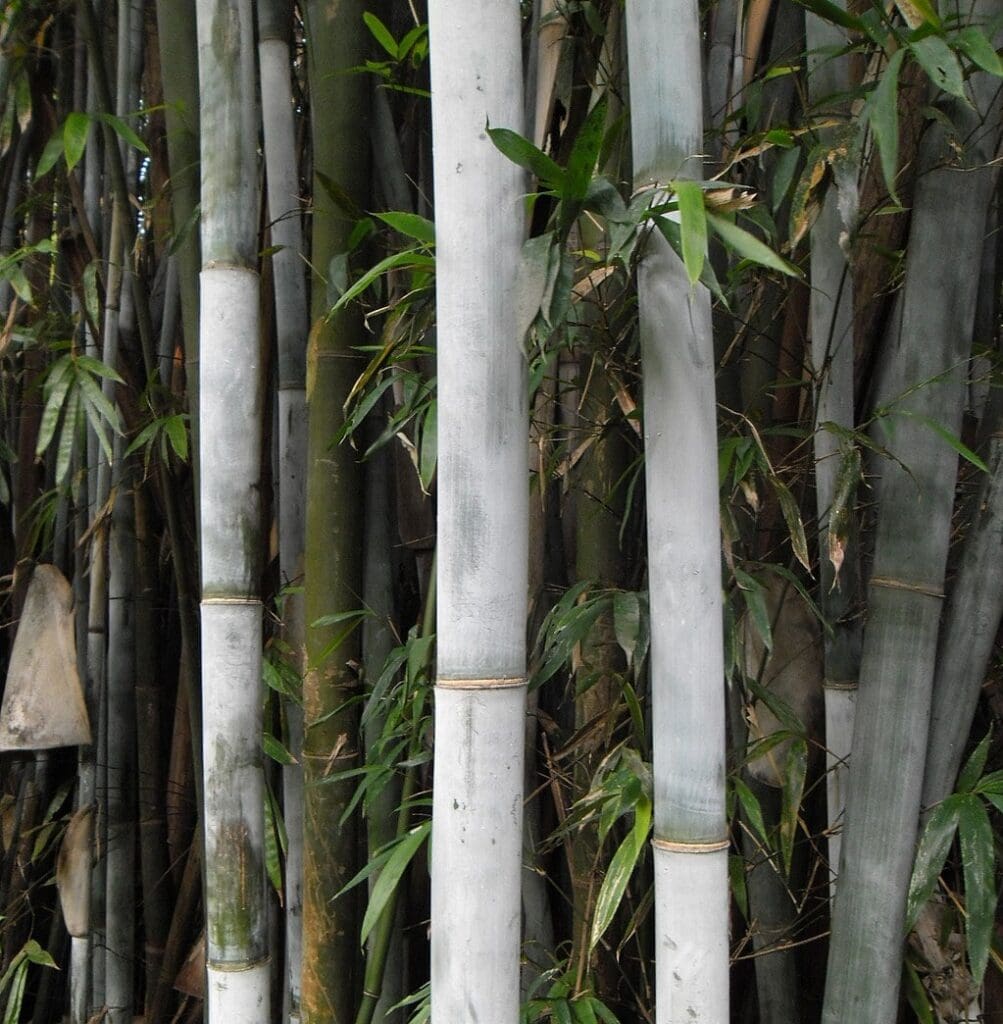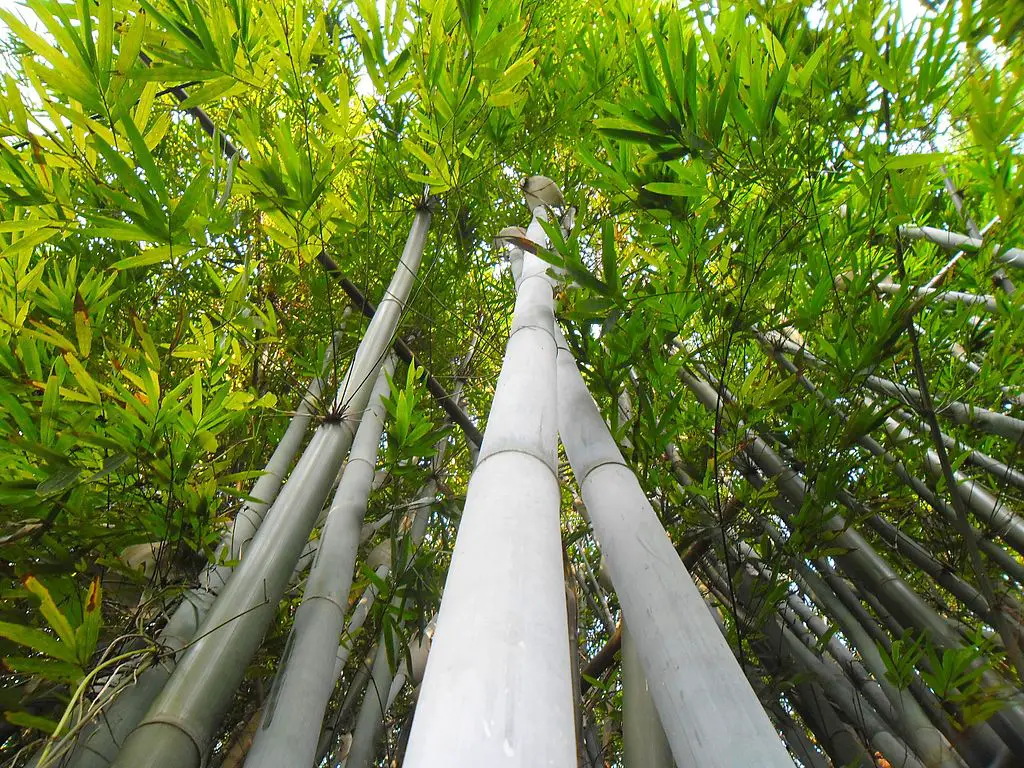Bambusa Chungii (Tropical Blue Bamboo) – Grow Guide
Bambusa chungii, commonly known as Tropical Blue Bamboo or Emperors Blue Bamboo, is a clumping bamboo species native to China and Vietnam. With its unique blue appearance due to a white powder on its culms, Bambusa chungii adds an aesthetic appeal to any garden.
This medium-sized evergreen bamboo grows in dense clumps. It is a vigorous grower with rapid growth and long internodes, making it suitable for various crafts and DIY projects.
Key Takeaways
- Bambusa chungii, also known as Tropical Blue Bamboo, is a clumping bamboo that grows up to 20-25 ft tall with an average diameter of 1.5 in.
- It has a unique blue appearance due to a white powder on its culms and is a vigorous grower with rapid growth. The long internodes make it suitable for crafts or DIY projects.
- Bambusa chungii requires a steady supply of water, nutrients, and food, and develops into large clumps in 3-5 years. It is best planted in full sun but can tolerate partial shade and becomes drought-tolerant once established.
- The bamboo thrives in full sun and can tolerate partial shade, but its growth rate may be reduced. It prefers fertile, well-draining soil and should be watered regularly, especially in the first few years. It is virtually disease-free but susceptible to fungal spots and pests such as bamboo borers and aphids.
Appearance
Bambusa chungii, also known as Tropical Blue Bamboo or Emperors Blue Bamboo, is a medium-sized evergreen bamboo with upright canes covered in a thin powder-like bloom that gives them an elegant baby-blue color when young and light green when mature.
The internodes of this bamboo measure 1-3 feet. It has many grouped branches of slightly different sizes, adding to its unique and stunning appearance in any garden.
Its blue coloration, along with its culm characteristics and leaf size, contribute to the overall beauty and aesthetic appeal of this bamboo variety.
Climate and Exposure
Thriving in tropical to subtropical climates, Bambusa chungii requires exposure to full sun or partial sun. To ensure optimal growth and development, it is important to consider the following factors:
- This bamboo species thrives in tropical to subtropical climates.
- It is best suited for regions with warm temperatures and high humidity.
- Recommended for USDA Plant Hardiness Zones 9-11.
- Full sun or partial sun exposure is essential for healthy growth.
- Positioning the plant in an area with maximum sunlight will promote its growth and overall appearance.
Hardiness and Soil
The hardiness and soil requirements of Bambusa chungii are crucial factors to consider for successful cultivation of this unique bamboo species.
Bambusa chungii is known for its ability to tolerate temperatures as low as -6°C, making it suitable for a range of climates. However, it thrives best in tropical to subtropical climates with full sun to partial sun exposure.
When it comes to soil, Bambusa chungii prefers sandy loam to clay loam soils that have good drainage. Soil fertility is important for the healthy growth of this bamboo species, so adding compost and mulch can improve soil quality.
It is recommended to mix compost with the soil before planting and apply mulch annually. By providing the right climate adaptation and ensuring proper soil conditions, gardeners can successfully cultivate Bambusa chungii.
Water Needs
Watering requirements are an important consideration for the successful cultivation of Bambusa chungii ‘Tropical Blue Bamboo’. This bamboo species has average water requirements and thrives with a steady supply of moisture.
To ensure its optimal growth, it is crucial to water thoroughly, especially during the first few months and years. During hot or dry seasons, watering should be done at least once a week to prevent dehydration.
Checking the soil moisture by digging into the top few inches is recommended to determine when watering is necessary. Signs of dehydration may include wilting or yellow leaves, indicating the need for more water.
It is essential to avoid soggy or swampy conditions as this can lead to root rot. Different irrigation methods such as drip irrigation or using a hose with a gentle spray attachment can be used to provide adequate water while avoiding overwatering.
Best Uses
Ideal for creating privacy screens, windbreaks, and hedges, Bambusa chungii offers a stunning and rare blue appearance that adds unparalleled beauty to any garden.
This versatile bamboo variety can be used to create living fences or windbreaks, providing a natural and visually appealing barrier. Its upright growth habit and dense clumping nature make it an excellent choice for creating privacy screens in residential or commercial settings.

Whether used as a striking focal point in the garden or as a functional element for added privacy, this bamboo species is highly valued for its aesthetic appeal and versatility.
Care and Maintenance
Pruning techniques play an important role in maintaining the health and aesthetic appeal of this bamboo variety. It is recommended to prune in early spring to remove any dead or damaged culms. This will promote new growth and maintain a tidy appearance. Additionally, regular pruning can help achieve the desired look for your Bambusa chungii.
Pest prevention is another crucial aspect of caring for this bamboo species. While Bambusa chungii is generally disease-free, it may be susceptible to fungal spots and pests such as bamboo borers and aphids. To prevent these issues, it is important to provide adequate water, food, and ventilation for your plants. Using insecticidal soaps or organic pesticides like neem oil can also help control pests.
Watering schedule is a vital consideration when caring for Bambusa chungii. In the first few months and years, thorough watering is necessary to establish healthy growth. However, it’s important to avoid soggy or swampy conditions as this can lead to root rot. During hot or dry seasons, watering at least once a week is recommended. Regularly checking the soil moisture level by digging into the top few inches can help determine if additional water is needed.
By following proper pruning techniques, implementing effective pest prevention strategies, and adhering to a suitable watering schedule, you can ensure the optimal care and maintenance of your Bambusa chungii ‘Tropical Blue Bamboo’.
Propagation
Propagation of Bambusa chungii can be achieved through root divisions or by taking cuttings of young rhizomes. Root division is a common propagation technique. The clump is carefully dug up and divided into smaller sections, each with its own set of roots and culms. These divisions can then be replanted in suitable soil and given proper care to encourage new growth.
Another method is taking cuttings from young rhizomes. This involves selecting healthy shoots and removing them from the parent plant. These cuttings can be planted in a well-draining soil mix and kept moist until they develop their own roots.
Both propagation techniques require attention to detail and patience but can result in successful establishment of new Bambusa chungii plants.
Conclusion
Bambusa chungii is a visually striking bamboo species suitable for warmer climates. Overall, Bambusa chungii adds beauty to gardens as a hedge, privacy screen, or windbreak option.

